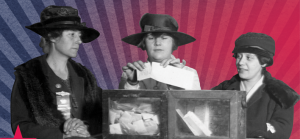 To make the most out of Women’s History Month, I went to the National Constitution Center to view their exhibits and see how they incorporated women’s history into the Constitutional history of the United States. I had not been to this site for many years – not since I was a child- and my nostalgia for the history showed here made me expect magic and inspire national pride in me. I expected to learn about the founding of our nation and here about the key players that shaped the United States into what it is today. My childlike wonder may have caused me to be naïve, but I truly was expecting more women included in the main exhibits, especially since the museum boasted about its female history in a pamphlet about Women’s History Month. The National Constitution Center is lacking in the incorporation of female contributions to the development of this nation.
To make the most out of Women’s History Month, I went to the National Constitution Center to view their exhibits and see how they incorporated women’s history into the Constitutional history of the United States. I had not been to this site for many years – not since I was a child- and my nostalgia for the history showed here made me expect magic and inspire national pride in me. I expected to learn about the founding of our nation and here about the key players that shaped the United States into what it is today. My childlike wonder may have caused me to be naïve, but I truly was expecting more women included in the main exhibits, especially since the museum boasted about its female history in a pamphlet about Women’s History Month. The National Constitution Center is lacking in the incorporation of female contributions to the development of this nation.
I visited the Richard and Helen DeVos Exhibition Hall, which is a chronology of the making of the United States. While I commend this exhibit for its interactivity, I am concerned about its lack of female contributions. The center had a pamphlet detailing the “Must-see highlights” in their exhibit to celebrate Women’s History Month. The seven highlights included shout outs to t, and a surprisingly inclusive American National Tree offering biographies of influential American citizens. The fact that there are only seven highlights that they chose from the entire museum is troubling. The NCC’s mission statement reads that “the Constitution Center brings the United States Constitution to life by hosting interactive exhibits and constitutional conversations and inspires active citizenship by celebrating the American constitutional tradition,” (National Constitution Center). The main exhibit shows a startling lack of female contribution to the United States Constitution history. Along with the women that they did mention, they could have included Florence Kelley and the National Consumers’ League, the implications of Roe v. Wade, and more women of color just to name a few. Asserting that their exhibits show “celebrate the American constitutional tradition,” while barely showing female contributions diminishes and belittles the contributions that they did make.
With all of their faults, the NCC’s American National Tree exhibit does merit some celebration. This exhibit allowed patrons to learn about over influential citizens through biographies. It showed the history of many women as well as men. This exhibit even seemed to have just as many women as there were men. I was impressed by this contribution, and I wished that they would have done more of this throughout the museum.
The National Constitution Center has the potential to become an effective representation of the importance of constitutional history. In order to do this, they must include more information about women. They should focus more on movements, events, and collective accomplishments rather than the lives of individual women. This shows the female’s greater contributions to society today, (Alice-Kessler Harris and Sonya Michel). They cannot erase the importance of women from constitutional history. By doing this, they risk the alienation from an entire gender. When young women enter this institution they deserve to see their faces represented in the exhibits. Inspiring active citizenship among one gender inspires a lack of self-efficacy in the other.
References
“About the Constitution Center,” Constitutioncenter.org http://constitutioncenter.org/about
“How to Build a Women’s History Museum,” Alice Kessler Harris and Sonya Michel. History
News Network, 2014. http://historynewsnetwork.org/article/157004
